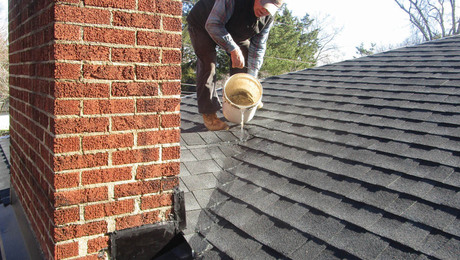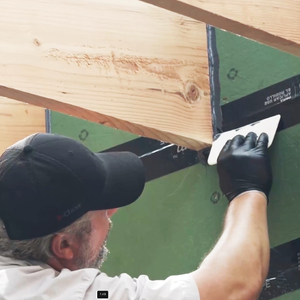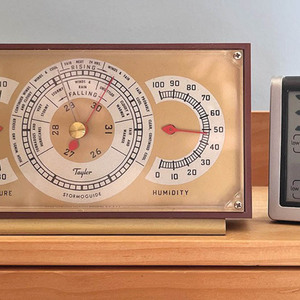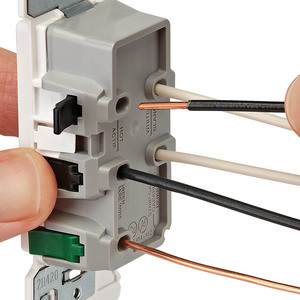My neighbor has an upstairs apt above his two car garage.
It has a window a/c unit.
It has soffit vents all around, no ridge vent.
Unsure of what or if any inulation.
He has recessed lighting.
On warm days, when the a/c is on, his cans sweat! he says it will develop quite alot of water on them! What do you’all think?
—————————————————————————–
WWPD



















Replies
Electrical equipment is far more water-tolerant than most people think. He's got several hazards, though:
1) If he reaches up there to change a bulb when it's wet, he could get zapped.
2) Dripping moisture could crack a bulb.
3) Eventually, moisture will corrode the heck out of the things, and if it goes far enough there could be a fire hazard. It would probably take decades for this to occur, though.
I think his roof ventilation is inadequate, possibly the insulation is as well
He needs a roof vent for outflow of hot air, all he has with soffit vents is inflow, but not much will flow in without making it possible to establish a full convection current.
He needs IC cans
Welcome to the
Taunton University of Knowledge FHB Campus at Breaktime.
where ...
Excellence is its own reward!
Ventillation makes little difference -- might even make things worse. The problem is that the surface temperature of the cans is below the dewpoint of the outside air.The simplest solution (if access isn't too difficult) would be to box in the cans. This can be done from above with scraps of drywall screwed to a 2x2 wood frame. Or, if the cans are IC rated, they can be tightly packed in insulation.
People never lie so much as before an election, during a war, or after a hunt. --Otto von Bismarck
I agree. Had a customer with this problem... water stains on the ceiling around can lights in the bathroom. Inadequately insulated attic above. We changed them out for IC rated cans and packed them tightly with FG. Problem stopped. I told them it wouldn't be a bad idea to use the bath fan too, or maybe put it on a humidistat.
This is in Florida where it is humid.and hothot humid air drifts into the attic and hits the cold cans.
With proper venting, the attic would not be as hot or humid, so there would be less condensation.
And with IC cans, there would be less leakage into the attic
Welcome to the Taunton University of Knowledge FHB Campus at Breaktime. where ... Excellence is its own reward!
Venting will maybe make the attic cooler, but no less humid. The air in the conditioned space has LOWER humidity than the outside air, so any humidity in the attic is coming from the outside. Heating air (without a source of added moisture) doesn't make it more humid.
People never lie so much as before an election, during a war, or after a hunt. --Otto von Bismarck
You miss the point that warmer air can carry and hold more moisture
Welcome to the Taunton University of Knowledge FHB Campus at Breaktime. where ... Excellence is its own reward!
But where does the moisture come from??? You miss the point that the only source of moisture is the outside air.
People never lie so much as before an election, during a war, or after a hunt. --Otto von Bismarck
Regardless, the roof needs to be properly vented. If there is water dripping down from the cans, where else is the moisture gathering that simply isn't seen. Proper venting is basic building 101.
I'd have to say it's surprising if adding extra fiberglass to an ic can would help all that much. Fiberglass allows so much free airflow that it seems a sure thing to get moisture condensing under the fiberglass. The fiberglass will probably hold the water rather than it dripping down the ceiling so it may seem drier.
If there's room I'd feel much more comfortable boxing in the cans with tightly sealed joints that effectively create a moisture barrier.
Beer was created so carpenters wouldn't rule the world.
Yeah, insulation would only help if it keeps the moisture away. Tightly packing fiberglass around the cans would probably do it, but loosely covering the cans with FG would just make matters worse. Enclosing the cans in a box would be better.More ventillation could actually make things worse. It would make the area cooler, increasing the likelihood that the dew point would be reached, and it would negate any mixing of the drier inside air with the attic air.
People never lie so much as before an election, during a war, or after a hunt. --Otto von Bismarck
Sadly there is no access into the "attic", sans cutting a hole in the roof
it's a 4/12 pitch.
I was wondering if possibly the a/c window unit was cooling to fast and not have a return to help move moisture out of the living area?
Just wondering. He was greatly concerned that it may be some sort of fire hazard.
I said I think at this time the worst is moisture damage.
-----------------------------------------------------------------------------
WWPD
Our house is 4/12, and I've been all over the attic area. 'Tain't fun, but it's doable.The A/C is removing moisture from the living area (and dripping/spraying it outside). If it weren't, it would be raining inside, since the inside air temp is below the outside dewpoint.Not much he can do without somehow gaining access. It's might help a little to seal any air leaks around and through the cans, so that cool air isn't drawn into the attic or moist air pulled down. Basically what you have there is a weather front -- cool dry air bumping into warm moist air.I am a little curious: Does he get this condensation even when the cans are lit, or only when they're turned off. One would think that the heat from the cans would be sufficient to prevent condensation.If he's got cans that are never turned on he should cover them on the inside with something, to keep the cold air away from them.
People never lie so much as before an election, during a war, or after a hunt. --Otto von Bismarck
I would probably get a gable end vent big enough to crawl through if that was necessary, and hinge the instalation of it.
Welcome to the Taunton University of Knowledge FHB Campus at Breaktime. where ... Excellence is its own reward!